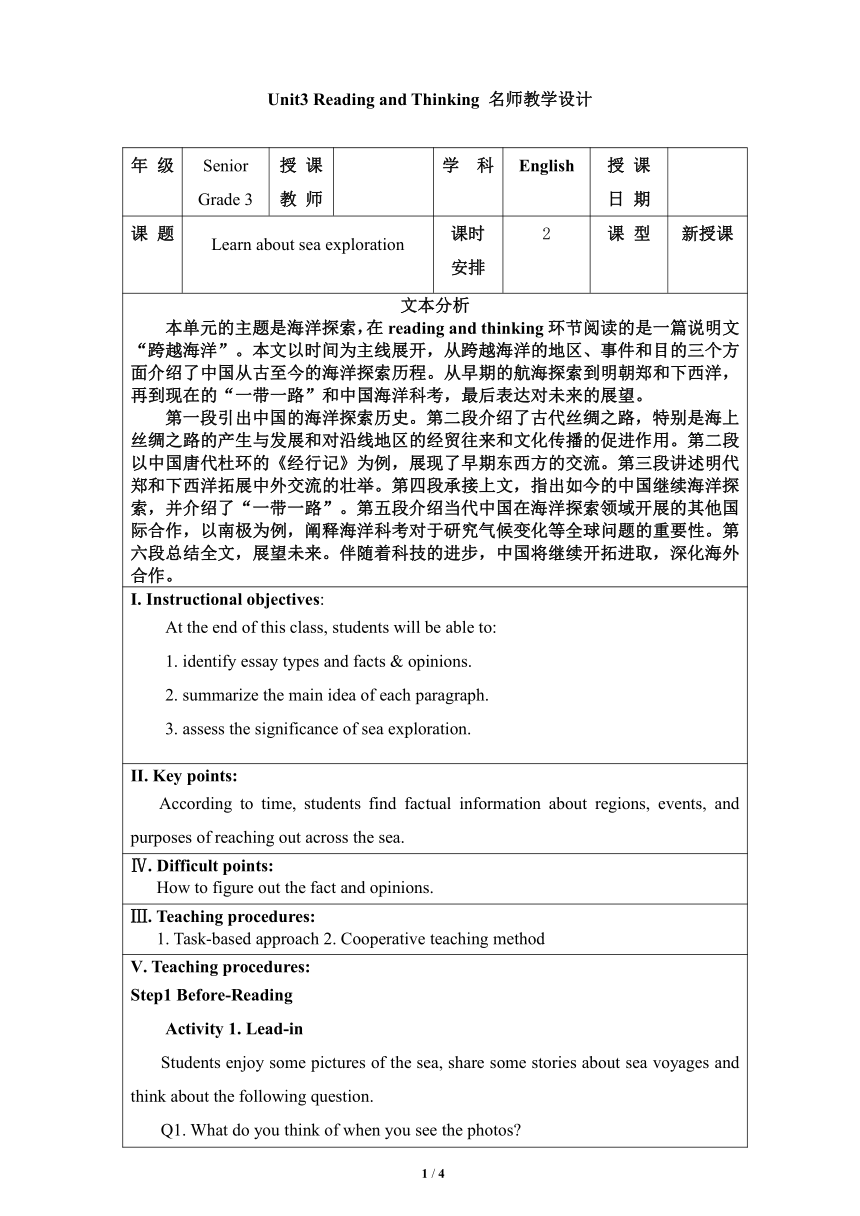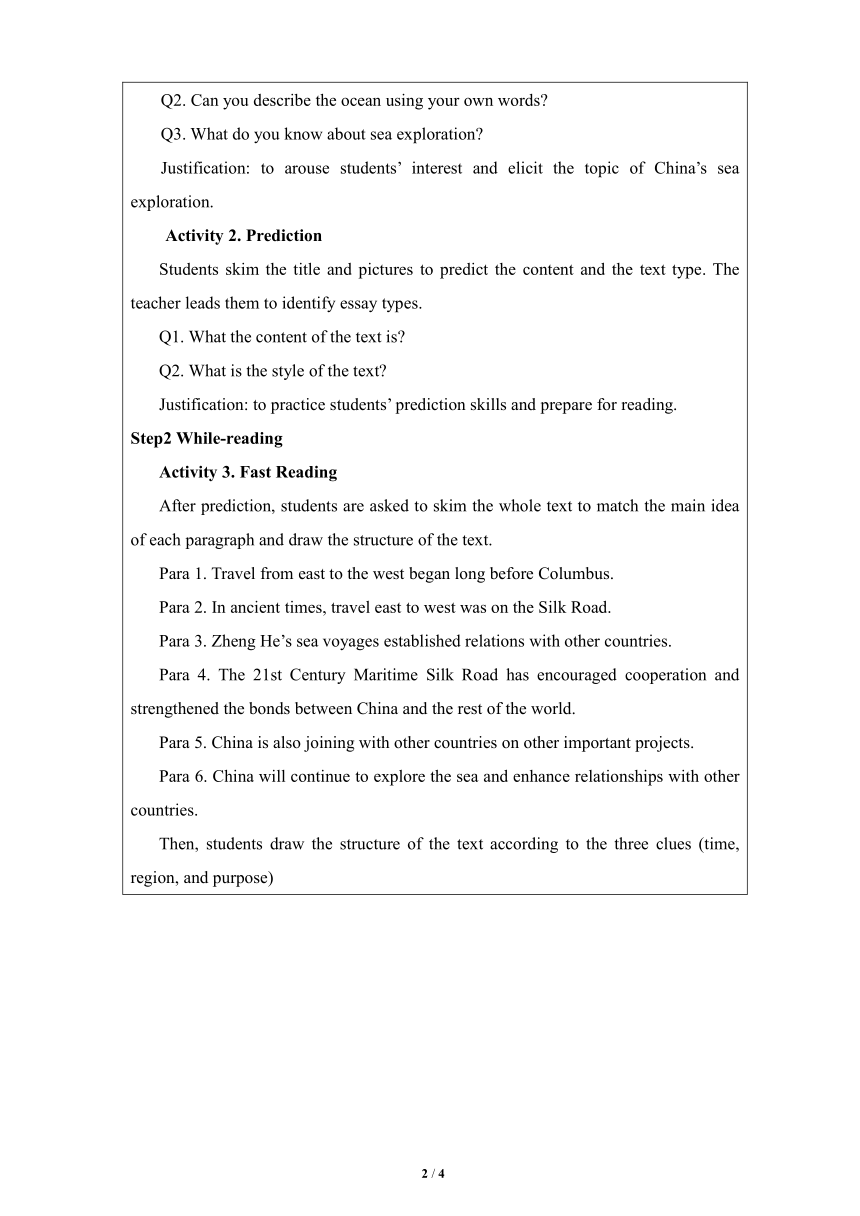人教版(2019)选择性必修 第四册Unit 3 Sea Exploration Reading and Thinking 名师教学设计(表格式)
文档属性
| 名称 | 人教版(2019)选择性必修 第四册Unit 3 Sea Exploration Reading and Thinking 名师教学设计(表格式) |

|
|
| 格式 | doc | ||
| 文件大小 | 109.5KB | ||
| 资源类型 | 教案 | ||
| 版本资源 | 人教版(2019) | ||
| 科目 | 英语 | ||
| 更新时间 | 2023-03-15 07:45:19 | ||
图片预览


文档简介
Unit3 Reading and Thinking 名师教学设计
年 级 Senior Grade 3 授 课教 师 学 科 English 授 课日 期
课 题 Learn about sea exploration 课时安排 2 课 型 新授课
文本分析本单元的主题是海洋探索,在reading and thinking环节阅读的是一篇说明文“跨越海洋”。本文以时间为主线展开,从跨越海洋的地区、事件和目的三个方面介绍了中国从古至今的海洋探索历程。从早期的航海探索到明朝郑和下西洋,再到现在的“一带一路”和中国海洋科考,最后表达对未来的展望。第一段引出中国的海洋探索历史。第二段介绍了古代丝绸之路,特别是海上丝绸之路的产生与发展和对沿线地区的经贸往来和文化传播的促进作用。第二段以中国唐代杜环的《经行记》为例,展现了早期东西方的交流。第三段讲述明代郑和下西洋拓展中外交流的壮举。第四段承接上文,指出如今的中国继续海洋探索,并介绍了“一带一路”。第五段介绍当代中国在海洋探索领域开展的其他国际合作,以南极为例,阐释海洋科考对于研究气候变化等全球问题的重要性。第六段总结全文,展望未来。伴随着科技的进步,中国将继续开拓进取,深化海外合作。
Ⅰ. Instructional objectives:At the end of this class, students will be able to:1. identify essay types and facts & opinions.2. summarize the main idea of each paragraph.3. assess the significance of sea exploration.
Ⅱ. Key points:According to time, students find factual information about regions, events, and purposes of reaching out across the sea.
Ⅳ. Difficult points: How to figure out the fact and opinions.
Ⅲ. Teaching procedures: 1. Task-based approach 2. Cooperative teaching method
Ⅴ. Teaching procedures:Step1 Before-ReadingActivity 1. Lead-inStudents enjoy some pictures of the sea, share some stories about sea voyages and think about the following question. Q1. What do you think of when you see the photos Q2. Can you describe the ocean using your own words Q3. What do you know about sea exploration Justification: to arouse students’ interest and elicit the topic of China’s sea exploration.Activity 2. PredictionStudents skim the title and pictures to predict the content and the text type. The teacher leads them to identify essay types. Q1. What the content of the text is Q2. What is the style of the text Justification: to practice students’ prediction skills and prepare for reading.Step2 While-readingActivity 3. Fast ReadingAfter prediction, students are asked to skim the whole text to match the main idea of each paragraph and draw the structure of the text.Para 1. Travel from east to the west began long before Columbus.Para 2. In ancient times, travel east to west was on the Silk Road.Para 3. Zheng He’s sea voyages established relations with other countries.Para 4. The 21st Century Maritime Silk Road has encouraged cooperation and strengthened the bonds between China and the rest of the world.Para 5. China is also joining with other countries on other important projects.Para 6. China will continue to explore the sea and enhance relationships with other countries.Then, students draw the structure of the text according to the three clues (time, region, and purpose)Justification: to train students’ ability to summarize the main idea and extract keywords; to foster students’ critical thinking.Activity 4. Detailed ReadingStudents read the text carefully to think about some related questions in each paragraph and find factual information about regions, events, and purposes of reaching out across the sea. Q 1. What drives people to reach out across the sea Q 2. Why did Marco Polo’s tales inspire European explorers to search for sea routes from west to east Q 3. What is the purpose of the Maritime silk road Q 4. What benefit can be got from negotiating trade deals Q 5. What is the purpose of sea exploration during the Ming Dynasty Q 6. What’s the difference between the ancient Silk Road and the Ming Dynasty Silk Road Q 7. It Zheng He’s voyages successful and meaningful Why Q 8. What is the function of the last sentence Q 9. What is the purpose of the Belt and Road Initiative Q 10. What bonds do you think can be strengthened between China and the rest of the world in the Belt and Road Initiative Q 11. Why will China continue to reach out across the sea far into the future Q12. Why does China join its friends and other nations on other important projects Q13. What is the meaning of reaching out across the sea Justification: to practice reading a passage for details and keywords. Help students to fully understand the text to support Step 4.Step 3. Post-readingActivity 4. Group DiscussionAfter reading the whole passage, the teacher asks the students to discuss the following questions with their partners and make notes about facts and opinions:Q1. What achievements has China made in reaching out across the sea Q2. What effects did China’s reaching out across the sea in the last past have on the world Q3. What about other countries Q4. Which countries reached out across the sea in the past and why Q5. What benefits and problems did those countries get from doing this Q6. What effects did reaching out across the sea in the past have on the world Q5. Are there questions discussed on the same aspect Q6. When you think about one historical or contemporary event, which aspects should you consider to gain a full understanding Q7. Are there questions discussed on the same aspect Q8. When you think about one historical or contemporary event, which aspects should you consider to gain a full understanding Justification: foster students’ critical thinking and their ability to identify the facts & opinions.Ⅵ. Homework The students write a short essay according to what they have learned.
2 / 2
年 级 Senior Grade 3 授 课教 师 学 科 English 授 课日 期
课 题 Learn about sea exploration 课时安排 2 课 型 新授课
文本分析本单元的主题是海洋探索,在reading and thinking环节阅读的是一篇说明文“跨越海洋”。本文以时间为主线展开,从跨越海洋的地区、事件和目的三个方面介绍了中国从古至今的海洋探索历程。从早期的航海探索到明朝郑和下西洋,再到现在的“一带一路”和中国海洋科考,最后表达对未来的展望。第一段引出中国的海洋探索历史。第二段介绍了古代丝绸之路,特别是海上丝绸之路的产生与发展和对沿线地区的经贸往来和文化传播的促进作用。第二段以中国唐代杜环的《经行记》为例,展现了早期东西方的交流。第三段讲述明代郑和下西洋拓展中外交流的壮举。第四段承接上文,指出如今的中国继续海洋探索,并介绍了“一带一路”。第五段介绍当代中国在海洋探索领域开展的其他国际合作,以南极为例,阐释海洋科考对于研究气候变化等全球问题的重要性。第六段总结全文,展望未来。伴随着科技的进步,中国将继续开拓进取,深化海外合作。
Ⅰ. Instructional objectives:At the end of this class, students will be able to:1. identify essay types and facts & opinions.2. summarize the main idea of each paragraph.3. assess the significance of sea exploration.
Ⅱ. Key points:According to time, students find factual information about regions, events, and purposes of reaching out across the sea.
Ⅳ. Difficult points: How to figure out the fact and opinions.
Ⅲ. Teaching procedures: 1. Task-based approach 2. Cooperative teaching method
Ⅴ. Teaching procedures:Step1 Before-ReadingActivity 1. Lead-inStudents enjoy some pictures of the sea, share some stories about sea voyages and think about the following question. Q1. What do you think of when you see the photos Q2. Can you describe the ocean using your own words Q3. What do you know about sea exploration Justification: to arouse students’ interest and elicit the topic of China’s sea exploration.Activity 2. PredictionStudents skim the title and pictures to predict the content and the text type. The teacher leads them to identify essay types. Q1. What the content of the text is Q2. What is the style of the text Justification: to practice students’ prediction skills and prepare for reading.Step2 While-readingActivity 3. Fast ReadingAfter prediction, students are asked to skim the whole text to match the main idea of each paragraph and draw the structure of the text.Para 1. Travel from east to the west began long before Columbus.Para 2. In ancient times, travel east to west was on the Silk Road.Para 3. Zheng He’s sea voyages established relations with other countries.Para 4. The 21st Century Maritime Silk Road has encouraged cooperation and strengthened the bonds between China and the rest of the world.Para 5. China is also joining with other countries on other important projects.Para 6. China will continue to explore the sea and enhance relationships with other countries.Then, students draw the structure of the text according to the three clues (time, region, and purpose)Justification: to train students’ ability to summarize the main idea and extract keywords; to foster students’ critical thinking.Activity 4. Detailed ReadingStudents read the text carefully to think about some related questions in each paragraph and find factual information about regions, events, and purposes of reaching out across the sea. Q 1. What drives people to reach out across the sea Q 2. Why did Marco Polo’s tales inspire European explorers to search for sea routes from west to east Q 3. What is the purpose of the Maritime silk road Q 4. What benefit can be got from negotiating trade deals Q 5. What is the purpose of sea exploration during the Ming Dynasty Q 6. What’s the difference between the ancient Silk Road and the Ming Dynasty Silk Road Q 7. It Zheng He’s voyages successful and meaningful Why Q 8. What is the function of the last sentence Q 9. What is the purpose of the Belt and Road Initiative Q 10. What bonds do you think can be strengthened between China and the rest of the world in the Belt and Road Initiative Q 11. Why will China continue to reach out across the sea far into the future Q12. Why does China join its friends and other nations on other important projects Q13. What is the meaning of reaching out across the sea Justification: to practice reading a passage for details and keywords. Help students to fully understand the text to support Step 4.Step 3. Post-readingActivity 4. Group DiscussionAfter reading the whole passage, the teacher asks the students to discuss the following questions with their partners and make notes about facts and opinions:Q1. What achievements has China made in reaching out across the sea Q2. What effects did China’s reaching out across the sea in the last past have on the world Q3. What about other countries Q4. Which countries reached out across the sea in the past and why Q5. What benefits and problems did those countries get from doing this Q6. What effects did reaching out across the sea in the past have on the world Q5. Are there questions discussed on the same aspect Q6. When you think about one historical or contemporary event, which aspects should you consider to gain a full understanding Q7. Are there questions discussed on the same aspect Q8. When you think about one historical or contemporary event, which aspects should you consider to gain a full understanding Justification: foster students’ critical thinking and their ability to identify the facts & opinions.Ⅵ. Homework The students write a short essay according to what they have learned.
2 / 2
